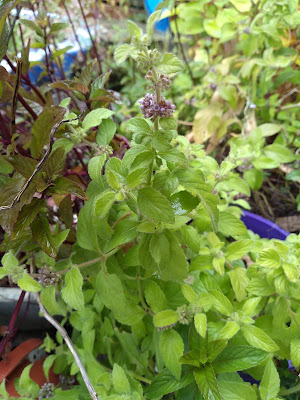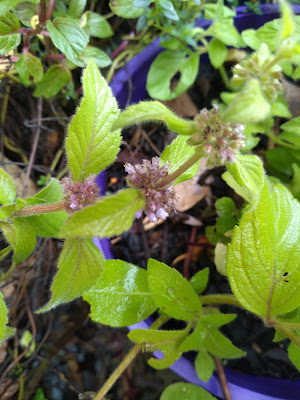I heard about rice paddy herb, aka Rau Om, years ago, and have wanted to try it ever since. Rice Paddy Herb (Limnophila aromatica) is a perennial edible plant that is said to taste/smell like citrus and cumin. Other places say it is similar to coriander seed. Other places describe it as being spicy, lively and reminiscent of citrus or curry. Sounds intriguing.
Everyone says the best way to grow it is to get a bunch of rice paddy herb from the grocers and grow a cutting from there, unfortunately I have never seen rice paddy herb anywhere. Very few online places sell live plants, and when you factor in postage, unless you also get other plants from there, it puts the price out of reach. So it has taken me a few years to actually get one.
I recently got some rice paddy herb (and some other nice edible plants) from Midsummer Herbs, and was very impressed. Firstly, there were several plants in my package, all were healthy and strong, and they were packaged well for postage.
Secondly, and far more importantly, was the smell and taste of this plant. Rice paddy herb really does smell spicy and lively like citrus and cumin, but far better. This plant has already exceeded my expectations. It smells incredible.
Rice paddy herb is commonly grown in Vietnam and other wet tropical places, it loves water and can be found in rice paddies or roadside ditches with water. Some people grow this submerged in an aquarium as an ornamental plant. For some inexplicable reason it is not commonly grown in Australia.
Rice paddy herb loves water, humidity, and heat. Apparently it can be difficult to grow in temperate areas. Which makes me wonder why I got this plant going into winter instead of waiting until spring...hmmm...
Most references to over wintering this plant speak of wrapping the plant, pot and all, in a plastic bag. This is meant to increase humidity and help reduce the severity of temperature swings.
As Christina from Midsummer Herbs gave me several plants I am able to try growing it in a few different ways and hopefully at least one makes it through winter.
I have a cutting sitting in some water on the window sill. I should probably take that to work and keep it on my desk as it is usually pretty warm in the office and it can get cold in my house over night.
 |
Rice Paddy Herb
|
I have some rice paddy herb planted in pots, under the shelter of the north facing verandah, next to a brick wall. They won't get any frost there, hopefully the brick wall helps keep them a little warmer. They will get some direct sunlight first thing in the morning, as well as bright indirect sunlight during the day.
I covered one in a plastic bottle with the bottom cut off, and the other with a plastic bag. I plan to keep an eye on them and move them if they appear to be declining too badly.
 |
Rice paddy herb with plastic bag covering it
|
 |
Rice Paddy Herb with a plastic bottle for protection
|
I have grown some tropical plants over winter and had great success as long as there is no frost or ice on them. I have tried to grow other species and they died quickly as soon as the temperature got too low even without frost or ice.
I have no idea how rice paddy herb will cope over winter, so I am also growing a plant in a small pot on the kitchen window sill where it will be a bit warmer over winter. I have grown micro tomatoes there over winter, so there is a chance my rice paddy herb should be ok. This pot is also sitting in water, and has a plastic bag over it to increase humidity. I do fear that being close to the window may be too cold at night, or it may experience temperature swings that are too large for it to cope with.
 |
Rice Paddy Herb on kitchen window sill
|
As well as these I also put two very small plants in a floating pot of herbs in my goldfish aquaponics barrel. I have lower hopes of this surviving as it will likely get too cold out there, but it may be ok. You need to look closely, one can be seen in the bottom left of the picture below.
 |
Rice Paddy Herb in aquaponics - you need to look closely to see it
|
There is a chance that my rice paddy herb will survive in the aquaponics because the other plants may provide a microclimate to shelter them from the cold, the large volume of water should retain some heat, and the barrel is under the eves of the house next to a brick wall, so the whole thing may be able to retain enough heat for it to survive. We have already had a couple of nights where the temperature has dropped below -6C and so far everything looks ok, but we will see what happens once this happens regularly over winter.
I think over summer when the weather is warm that growing rice paddy herb in aquaponics may be the way to go in my climate as it gets hot and dry here. In aquaponics rice paddy herb would have unlimited water, constant humidity, and access to a stream of nutrients from the fish waste.
If things go too poorly for all my plants I have a heat mat in the garage that I use to
germinate seeds, I could move one or two plants onto this heat mat and put it
under lights. Hopefully I notice in time and am able to save this
little plant. I haven't started them on the heat mat because they may
do just fine where I have them.
Hopefully at least one of my plants survives and I can give this a go over summer. If not, given how much I like the smell and taste of this herb, I think I will have to try and buy another one.
________________________________________________________________________________
Update after one month:
Almost the opposite of what I had expected.
The aquaponics one lost a few leaves from frost, but generally looks good. It may still die once we get a lot more frosts, or it may power through. I really think that once the weather warms aquaponics will be a good place to grow rice paddy herb.
The two growing outside near the brick wall both got a little cold damage, but also look like they should survive.
The one in a pot on the kitchen window sill is doing very poorly. It has suffered a lot and has died back somewhat. I moved it to another room as I thought being near a window the temperature swings may be too much, but it kept going down hill. I have just moved it into the garage on a heat mat and will see how that goes. Hopefully some bottom heat should help it pick up and get through the colder months.
The cutting I took and put in a glass of water is doing poorly. I moved it to the heat mat too. Hopefully a little heat should help it grow some roots.
__________________________________________________________________________________
Update after two and a half months
The aquaponics rice paddy herb had some damage from frosts, but is still alive. If it survives until spring I have a feeling it will do well in my little barrel.
The two outside near the brick wall are alive. They both were damaged from cold. Hopefully they survive.
The one that was in a pot on the kitchen window sill, then put on a heat mat, has died. The cutting in water that I put on a hear mat also died. This surprised me, I expected these to be the last ones alive if all else failed.
If all goes poorly I will have to buy another plant when the weather is warm because I really love rice paddy herb. I think getting plants before winter was my downfall, and if I had established plants leading into winter that they may have fared a lot better.


















































